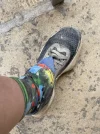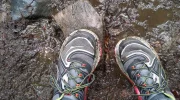I do not let longevity of footwear determine what I wear. I focus on on comfort of the footwear's fit and feel, and what the overall energy expenditure will be in using them. Then I consider what the conditions are expected to be like (cold, snow, ice). From there, I make my decision.
The actual reasons
for choosing a trail or road running shoe is what makes their overall lifespan shorter.
I used 5 pairs of trail runners on my thru-hike of the 2,650 mile long Pacific Crest Trail, mailing a pair at designated resupply points at defined mileage intervals. I converted to this type of footwear after decades of using hiking 'boots' for several reasons: significantly lighter weight, lessened risk for injury, comfort with the cushioning, and the lessened drain on energy levels caused by lifting the weight on my feet while walking 24 to 26 mile days.
For my Colorado Trail thru hike, and on my Caminos, I switched from the Brooks Leadville trail runner (no longer in production), to 1 model of Hoka One One, than later to a different Hoka One One model.
Not all trail runners have severely aggressive tread, and not all street running shoes provide adequate cushioning levels for use with hiking or distance walking.
Brands of street runners, like Saucony, Adidas, Nike, etc include models which a designed to be very light. These sacrifice cushioning to save weight because they are targeted to short distance running activities and do not need to provide all day walking support or comfort.
Other brands, like Hoka One One and New Balance, are focused more on cushioning and motion control; they remain far lighter than trail shoes (not trail runners) but can support distance walking over many hours. Saucony and Nike, for example, also feature more cushiony models of street runners, but the range of such models is not as broad as in other brands.
Also, if a shoe you try on does not feel comfortable when you try it on, it will never get better. This is a category of footwear that does not 'break in' like a heavier trail shoe or hiking shoe. They will somewhat mold in the footbed with some wear, but they need to feel good right out of the box.
If the shoes generally feel good, but have a teensy spot that is slightly tight, like at a toe joint, a shoe shop (not a shoe store) can stretch the shoe fabric somewhat which may deal with that teensy issue. This will do the same thing that wearing them for 100 miles would do. So if that stretching does not resolve the issue, return them and try a larger/wider size.
Of course, if you are like me and willing to take a knife of scissors to modify a niggling spot on the upper of a shoe, than you might decide that you are OK with waiting to see if walking stretches out that fabric upper just enough.

























